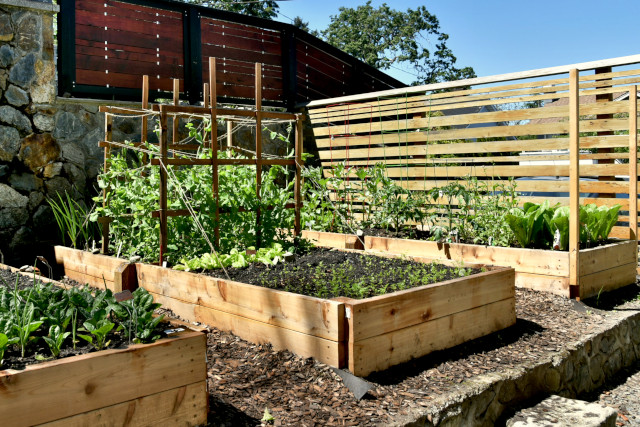Raised Garden Beds: Build Your Own
There are a lot of benefits to using raised garden beds. They can be more accessible for people with mobility issues and are easier on your back and knees. They prevent your soil from compacting and provide good drainage. In addition, they are also a good barrier for some pests such as slugs and snails. Not to mention, raised garden beds are actually less prone to weeds.
Build Your Own Raised Garden Beds
While you can purchase pre-made garden boxes, if you’re handy with tools (or know someone who is), they can be pretty simple to build. The benefit of this is that you can build the raised garden beds to the exact specifications of the space you have available.

Find the Perfect Spot
If you’re building your own garden boxes, the first thing to do is to figure out what you want to grow, and where on your property you want to do it. Take note of the amount of sun and shade the area receives. This is an essential part of planning your gardens. Keep this in mind when deciding what you want to grow. Also, make sure you’re not planting beyond the reach of your water supply – it won’t matter if it’s a low-lying part of your property if the plants are in raised garden beds.
Choose the Perfect Size
The depth of your bed is very important. Depending on what you’re growing, the plants might require more space for roots. At minimum, you should have 6 inches of soil, but ideally, you should have twice that.
It’s also important to consider what is near your raised garden beds. When placing the beds against a fence, don’t make them so wide that you can’t reach across. If the beds are only going to be accessible from one side, don’t make them any wider than about 4 feet. If you want them to be wider than that, make sure to leave yourself a pathway all around so your plants are accessible, particularly for harvesting if you’re growing fruits or veggies.

Select the Perfect Material
Once you’re ready to build, consider the different properties of materials. For instance, cinder blocks, rock, and concrete can be very heavy to work with. The plus side is that raised garden beds made with these materials will last for ages. However, this might not be a good thing if you enjoy being able to change things up. They can be more costly, and they tend to hold the heat more, particularly in the summer.
A lot of gardeners choose to use wood for their raised beds. Depending on the type of wood you choose, it could last you upwards of 20 years before it rots. Redwood and Black Locust have great longevity. Cedar is also a good option. Douglas Fir won’t last nearly as long – maybe only five to seven years – but, it is very cost-effective, and a good way to try raised beds to see if they’re right for you without a deep cost investment. In addition, it gives you the freedom to relocate your garden beds more regularly.
Reinforce the Raised Garden Beds if Necessary
If you decide to use wood and want to have beds deeper than about 12 inches or longer than 6 feet, be sure to add cross-supports, so the wood doesn’t bow. Remember, soil is heavy!

Control the Growing Medium
Speaking of soil, one of the best benefits of raised beds is that you have control over the quality of the soil your plants grow in. And when it comes to quality soil, the clear choice is BigYellowBag Black Garden Soil. BigYellowBag Black Garden Soil is made up of a mix of black loam, peat loam, compost, and manure. Loam is a soil type comprised of sand, silt, and clay in the right ratios so that there is a perfect balance of drainage and moisture retention. The soil has light and fluffy properties that make it a fantastic growing medium. It is also packed with essential nutrients and organic matter.
Gardening is a great way to keep active and in touch with nature.
Raised beds offer an opportunity to do just that, while lessening some of the harder aspects of the hobby. Get excited to build your own or buy some now!

